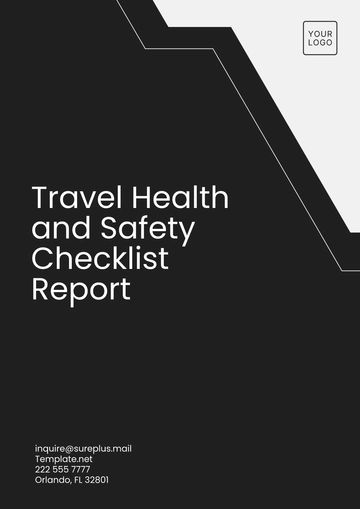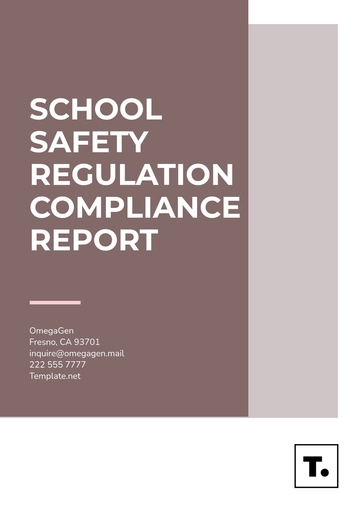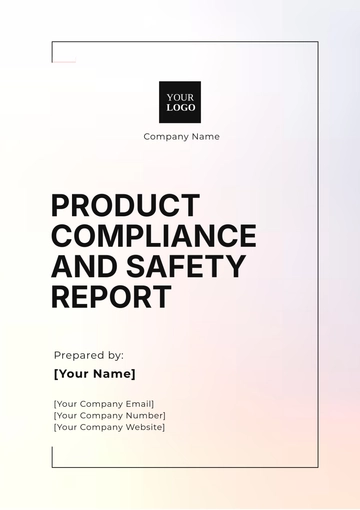Free Car Wash Safety Report Format

I. Introduction
Safety is paramount in the car wash industry, and at [Your Company Name], we prioritize the well-being of our employees and customers. This Car Wash Safety Report provides a comprehensive analysis of our current safety practices, identifies areas for improvement, and outlines actionable recommendations to enhance safety across all operations.
A. Safety Objectives
Ensure Employee Safety: Our primary objective is to ensure a safe working environment for all employees. This involves implementing and maintaining safety protocols that prevent accidents and injuries.
Customer Protection: Protecting our customers from potential hazards is critical. This includes ensuring safe car wash procedures and maintaining equipment to prevent malfunctions.
Regulatory Compliance: We aim to comply with all relevant safety regulations and standards. Regular audits and inspections are conducted to ensure adherence to safety laws.
B. Methodology
Data Collection: Collected data through safety audits, incident reports, and employee feedback. This data provided insights into current safety practices and identified areas for improvement.
Field Observations: Conducted field observations to assess safety practices in real-time. This method helped in identifying potential hazards and understanding the practical application of safety protocols.
Stakeholder Interviews: Interviewed employees and customers to gather their perspectives on safety. This feedback was instrumental in identifying strengths and weaknesses in our safety measures.
C. Scope of Report
Safety Protocols: The report covers existing safety protocols and their effectiveness. This includes standard operating procedures (SOPs) for handling equipment and chemicals.
Incident Analysis: Analyzes past safety incidents to identify common causes and preventive measures. This section provides a detailed breakdown of incidents and their impact.
Recommendations: Offers actionable recommendations to improve safety practices. These recommendations are based on the analysis of data collected and best practices in the industry.
II. Current Safety Protocols
A. Employee Training
Initial Training: All new employees undergo comprehensive safety training during their onboarding process. This training covers the proper use of equipment, handling of chemicals, and emergency procedures.
Ongoing Education: Regular safety workshops and refresher courses are conducted to ensure employees stay updated on the latest safety practices. These sessions reinforce the importance of adhering to safety protocols.
Certifications: Employees are encouraged to obtain safety certifications relevant to the car wash industry. Certified employees are better equipped to handle safety challenges and contribute to a safer work environment.
B. Equipment Maintenance
Regular Inspections: All car wash equipment undergoes regular inspections to ensure it is in good working condition. Preventive maintenance schedules are followed to avoid equipment failure.
Safety Features: Equipment is equipped with safety features such as emergency shut-off switches and guards. These features help prevent accidents during operation.
Repairs and Upgrades: Prompt repairs and necessary upgrades are carried out to maintain the safety and efficiency of equipment. This practice minimizes the risk of malfunctions and associated hazards.
C. Chemical Handling
Safety Data Sheets (SDS): Safety Data Sheets are provided for all chemicals used in the car wash. Employees are trained to understand and follow the safety guidelines outlined in the SDS.
Proper Storage: Chemicals are stored in designated areas with appropriate labeling and containment measures. This prevents accidental spills and exposures.
Personal Protective Equipment (PPE): Employees are required to wear PPE such as gloves, goggles, and aprons when handling chemicals. PPE usage is strictly enforced to minimize health risks.
III. Incident Analysis
The following table summarizes the key safety incidents that have occurred over the past year, along with their causes and outcomes:
Incident Type | Frequency | Cause | Outcome |
|---|---|---|---|
Slip and Falls | 10 | Wet floors, improper footwear | Minor injuries, one major injury |
Equipment Malfunctions | 5 | Lack of maintenance, operator error | Equipment downtime, minor injuries |
Chemical Exposure | 3 | Improper handling, PPE non-compliance | Minor skin irritation, no major injury |
Vehicle Damage | 7 | Operator error, equipment failure | Customer complaints, insurance claims |
A. Slip and Falls
Cause: Slip and fall incidents were primarily caused by wet floors and improper footwear. Wet floors are common in car wash environments, making slip-resistant footwear essential.
Outcome: These incidents resulted in minor injuries, with one case leading to a major injury requiring medical attention. Addressing wet floor hazards can significantly reduce the frequency of these incidents.
B. Equipment Malfunctions
Cause: Equipment malfunctions occurred due to lack of maintenance and operator error. Regular maintenance and proper training can prevent these malfunctions.
Outcome: Malfunctions led to equipment downtime and minor injuries. Ensuring regular maintenance and proper training for operators can mitigate these issues and enhance safety.
C. Chemical Exposure
Cause: Chemical exposure incidents were caused by improper handling and non-compliance with PPE requirements. Proper training and enforcement of PPE usage are critical in preventing these incidents.
Outcome: These incidents resulted in minor skin irritation but no major injuries. Ensuring proper handling and PPE compliance can eliminate the risk of chemical exposure.
D. Vehicle Damage
Cause: Vehicle damage incidents were attributed to operator error and equipment failure. Improving operator training and equipment maintenance can reduce these incidents.
Outcome: These incidents led to customer complaints and insurance claims. Addressing the root causes can enhance customer satisfaction and reduce financial liabilities.
IV. Safety Training Programs
A. Initial Training Program
Comprehensive Curriculum: The initial training program covers all aspects of car wash safety, including equipment operation, chemical handling, and emergency procedures. New employees receive hands-on training and theoretical knowledge to prepare them for their roles.
Experienced Instructors: Training sessions are conducted by experienced instructors who have extensive knowledge of car wash operations and safety protocols. Their expertise ensures that employees receive high-quality training.
Evaluation and Feedback: Employees undergo assessments to evaluate their understanding of safety protocols. Feedback is provided to address any gaps in knowledge and reinforce key safety practices.
B. Ongoing Training Initiatives
Regular Workshops: Regular workshops are conducted to update employees on the latest safety practices and regulatory changes. These workshops reinforce the importance of adhering to safety protocols.
Safety Drills: Periodic safety drills are conducted to prepare employees for emergency situations. These drills simulate real-life scenarios and test employees’ readiness and response.
Peer Learning: Employees are encouraged to share their safety experiences and best practices with their peers. This collaborative approach fosters a safety culture and continuous improvement.
C. Certification Programs
Safety Certifications: Employees are encouraged to pursue safety certifications relevant to the car wash industry. Certifications such as OSHA compliance and first aid training enhance their safety skills.
Incentives for Certification: Incentives such as bonuses and recognition are offered to employees who obtain safety certifications. This motivates employees to enhance their safety knowledge and skills.
Tracking and Monitoring: The progress of employees in obtaining certifications is tracked and monitored. This ensures that all employees meet the required safety standards.
V. Equipment Safety
A. Maintenance Schedule
Preventive Maintenance: A preventive maintenance schedule is followed to ensure all equipment is in optimal working condition. Regular checks and servicing prevent unexpected breakdowns and enhance safety.
Inspection Protocols: Detailed inspection protocols are in place to identify potential issues before they escalate. These protocols cover all critical components of the equipment.
Record Keeping: Maintenance and inspection records are meticulously kept to track the history of equipment performance. This data helps in identifying recurring issues and planning future maintenance.
B. Safety Features
Emergency Shut-Off: All equipment is equipped with emergency shut-off switches to quickly stop operations in case of an emergency. These switches are easily accessible and regularly tested.
Safety Guards: Safety guards are installed on all moving parts to prevent accidental contact. These guards are checked regularly to ensure they are in good condition.
Warning Labels: Clear warning labels are placed on all equipment to alert employees to potential hazards. These labels provide essential safety information and instructions.
C. Upgrades and Innovations
Technological Advancements: Keeping up with technological advancements in car wash equipment enhances safety and efficiency. Investing in modern, safer equipment reduces the risk of accidents.
Retrofits: Retrofitting older equipment with new safety features ensures that all equipment meets current safety standards. This practice extends the life of the equipment and enhances safety.
Continuous Improvement: Feedback from employees and safety audits is used to continuously improve equipment safety. This proactive approach ensures that safety measures evolve with changing needs.
VI. Chemical Safety
A. Handling Procedures
Proper Usage: Employees are trained on the proper usage of chemicals, including correct dosages and application methods. This training minimizes the risk of accidents and exposure.
Storage Guidelines: Chemicals are stored according to manufacturer guidelines to prevent spills and contamination. Designated storage areas are clearly labeled and equipped with containment measures.
Emergency Procedures: Clear emergency procedures are in place for handling chemical spills and exposures. Employees are trained to respond quickly and effectively to minimize harm.
B. Personal Protective Equipment (PPE)
Mandatory PPE: The use of PPE such as gloves, goggles, and aprons is mandatory when handling chemicals. PPE protects employees from exposure to harmful substances.
PPE Training: Employees receive training on the proper use and maintenance of PPE. This ensures that PPE is used correctly and provides adequate protection.
PPE Availability: Adequate supplies of PPE are always available to employees. Regular checks are conducted to ensure that PPE is in good condition and readily accessible.
C. Safety Data Sheets (SDS)
Access to SDS: Safety Data Sheets for all chemicals used are easily accessible to employees. SDS provide detailed information on the hazards and safe handling of chemicals.
SDS Training: Employees are trained to understand and use the information in SDS. This training helps them handle chemicals safely and respond appropriately to emergencies.
Regular Updates: SDS are regularly updated to reflect any changes in chemical formulations or safety guidelines. Employees are informed of these updates to ensure ongoing safety.
VII. Incident Reporting and Response
A. Reporting Mechanism
Incident Reporting System: A robust incident reporting system is in place to document all safety incidents. Employees are encouraged to report incidents promptly and accurately.
Anonymous Reporting: An anonymous reporting option is available to ensure that employees feel comfortable reporting incidents without fear of reprisal. This encourages more comprehensive reporting.
Data Analysis: Incident reports are analyzed to identify trends and root causes. This analysis helps in developing targeted interventions to prevent future incidents.
B. Emergency Response
Emergency Action Plan: A detailed emergency action plan outlines the steps to be taken in various emergency scenarios. This plan is regularly reviewed and updated.
First Aid Training: Employees receive first aid training to handle minor injuries and provide immediate care in emergencies. Trained first aiders are available on every shift.
Coordination with Authorities: Coordination with local emergency services ensures a swift response to major incidents. Contact information for emergency services is prominently displayed.
C. Follow-Up Procedures
Post-Incident Review: A thorough review is conducted after each incident to understand what happened and why. This review involves all relevant stakeholders.
Corrective Actions: Corrective actions are implemented based on the findings of the post-incident review. These actions aim to prevent similar incidents in the future.
Communication: Findings and corrective actions are communicated to all employees. This ensures that everyone is aware of the incident and the measures taken to enhance safety.
VIII. Recommendations
A. Enhance Employee Training
Expand Training Programs: Expanding training programs to cover more aspects of safety can enhance employee knowledge and preparedness. This includes advanced training in chemical handling and equipment operation.
Introduce Simulation Training: Introducing simulation training for emergency scenarios can improve employee response times and effectiveness. Simulations provide hands-on experience in a controlled environment.
Regular Refresher Courses: Conducting regular refresher courses ensures that employees stay updated on safety protocols. These courses reinforce the importance of safety practices.
B. Upgrade Equipment
Invest in Modern Equipment: Investing in modern, safer equipment can reduce the risk of accidents. Newer equipment often comes with advanced safety features.
Implement Predictive Maintenance: Using predictive maintenance technologies can prevent equipment failures before they occur. This proactive approach enhances safety and efficiency.
Safety Retrofits: Retrofitting older equipment with new safety features ensures that all equipment meets current safety standards. This practice extends the life of the equipment and enhances safety.
C. Improve Chemical Safety
Advanced Chemical Training: Providing advanced training in chemical safety can enhance employee handling skills. This includes detailed instruction on the properties and risks of different chemicals.
Enhanced Storage Solutions: Implementing enhanced storage solutions for chemicals can prevent spills and contamination. This includes using spill-proof containers and secure storage areas.
PPE Monitoring: Regular monitoring of PPE usage ensures that employees are adequately protected. This includes checking the condition of PPE and ensuring its proper use.
D. Strengthen Incident Reporting
Automate Reporting System: Automating the incident reporting system can streamline the reporting process. Automation ensures that incidents are promptly documented and analyzed.
Encourage Reporting: Encouraging a culture of safety reporting ensures that all incidents are reported. This includes recognizing and rewarding employees who report incidents.
Improve Data Analysis: Enhancing data analysis capabilities can identify trends and root causes more effectively. This helps in developing targeted interventions to prevent future incidents.
IX. Conclusion
This Car Wash Safety Report of [Your Company Name] provides a detailed analysis of our current safety practices and identifies areas for improvement. By enhancing employee training, upgrading equipment, improving chemical safety, and strengthening incident reporting, we can create a safer working environment for our employees and customers.
Implementing the recommendations outlined in this report will not only reduce the risk of accidents but also improve overall operational efficiency. Continuous monitoring and adaptation of safety practices are essential to maintaining a safe and productive car wash operation. Through our commitment to safety, [Your Company Name] can ensure the well-being of all stakeholders and achieve long-term success.
- 100% Customizable, free editor
- Access 1 Million+ Templates, photo’s & graphics
- Download or share as a template
- Click and replace photos, graphics, text, backgrounds
- Resize, crop, AI write & more
- Access advanced editor
Maintain high safety standards with the Car Wash Safety Report Format Template from Template.net! This customizable template helps you document safety incidents comprehensively. The editable layout ensures you can modify the report to your needs, leveraging the AI Editor Tool for precise and accurate reporting! Get your access right away!
You may also like
- Sales Report
- Daily Report
- Project Report
- Business Report
- Weekly Report
- Incident Report
- Annual Report
- Report Layout
- Report Design
- Progress Report
- Marketing Report
- Company Report
- Monthly Report
- Audit Report
- Status Report
- School Report
- Reports Hr
- Management Report
- Project Status Report
- Handover Report
- Health And Safety Report
- Restaurant Report
- Construction Report
- Research Report
- Evaluation Report
- Investigation Report
- Employee Report
- Advertising Report
- Weekly Status Report
- Project Management Report
- Finance Report
- Service Report
- Technical Report
- Meeting Report
- Quarterly Report
- Inspection Report
- Medical Report
- Test Report
- Summary Report
- Inventory Report
- Valuation Report
- Operations Report
- Payroll Report
- Training Report
- Job Report
- Case Report
- Performance Report
- Board Report
- Internal Audit Report
- Student Report
- Monthly Management Report
- Small Business Report
- Accident Report
- Call Center Report
- Activity Report
- IT and Software Report
- Internship Report
- Visit Report
- Product Report
- Book Report
- Property Report
- Recruitment Report
- University Report
- Event Report
- SEO Report
- Conference Report
- Narrative Report
- Nursing Home Report
- Preschool Report
- Call Report
- Customer Report
- Employee Incident Report
- Accomplishment Report
- Social Media Report
- Work From Home Report
- Security Report
- Damage Report
- Quality Report
- Internal Report
- Nurse Report
- Real Estate Report
- Hotel Report
- Equipment Report
- Credit Report
- Field Report
- Non Profit Report
- Maintenance Report
- News Report
- Survey Report
- Executive Report
- Law Firm Report
- Advertising Agency Report
- Interior Design Report
- Travel Agency Report
- Stock Report
- Salon Report
- Bug Report
- Workplace Report
- Action Report
- Investor Report
- Cleaning Services Report
- Consulting Report
- Freelancer Report
- Site Visit Report
- Trip Report
- Classroom Observation Report
- Vehicle Report
- Final Report
- Software Report





























